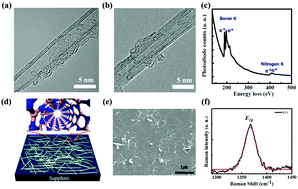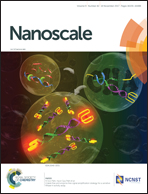Boron nitride nanotubes as a heat sinking and stress-relaxation layer for high performance light-emitting diodes†
Abstract
High-density threading dislocations, the presence of biaxial compressive strain, and heat generation are the major limitations obstructing the performance and reliability of light emitting diodes (LEDs). Herein, we demonstrate a facile epitaxial lateral overgrowth (ELOG) method by incorporating boron nitride nanotubes (BNNTs) on a sapphire substrate by spray coating to resolve the above issues. Atomic force microscopy, X-ray diffraction, micro-Raman, and photoluminescence measurements confirmed the growth of a high quality GaN epilayer on the BNNT-coated sapphire substrate with reduced threading dislocations and compressive strain owing to the ELOG process. GaN LEDs fabricated using this approach showed a significant enhancement in the internal quantum efficiency and electroluminescence intensity compared to conventional LEDs grown on sapphire. Moreover, reduced efficiency droop and surface temperature at high injection currents were achieved due to the excellent thermal stability and conductivity of BNNTs. Based on our findings we infer that the BNNTs would be a promising material for high power devices vulnerable to self-heating problems.



 Please wait while we load your content...
Please wait while we load your content...